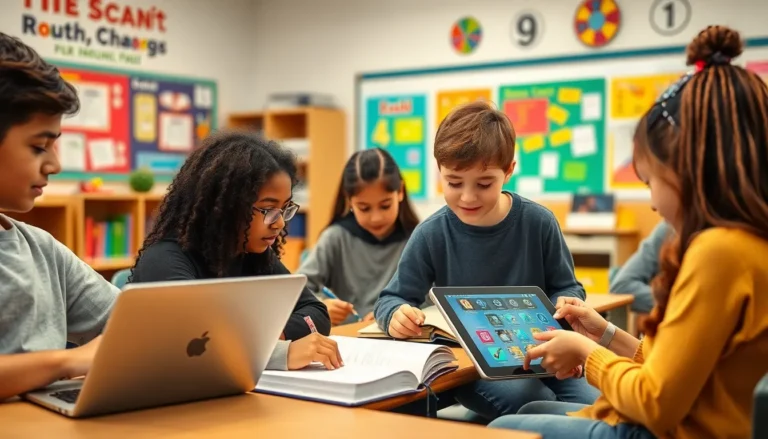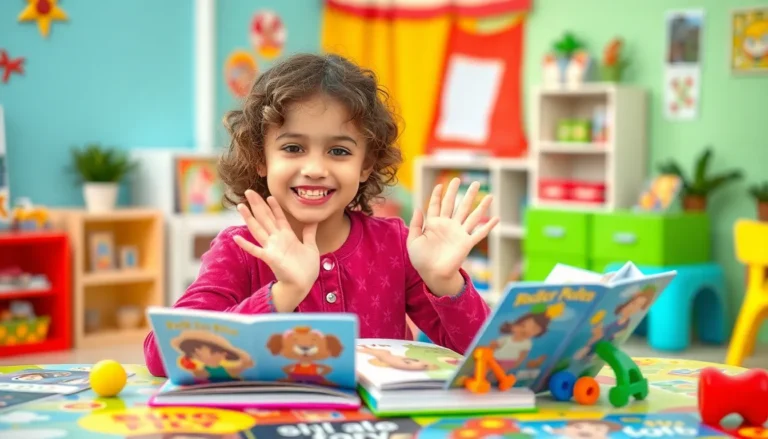In the colorful world of childhood, playtime isn’t just about fun; it’s a vital part of development. Enter parallel play, the unsung hero of early social interaction. Picture this: toddlers immersed in their own worlds, building block towers or racing toy cars, all while blissfully ignoring each other. It might look like solitary play, but it’s actually a crucial step in learning how to interact with others.
Parallel play is where kids develop independence and creativity while being in close proximity to their peers. It’s like throwing a party where everyone’s invited, but no one’s quite ready to mingle yet. This stage paves the way for future social skills, laying the groundwork for cooperative play and lasting friendships. So, let’s dive into the fascinating world of parallel play and discover why it’s more than just kids playing side by side.
Table of Contents
ToggleUnderstanding Parallel Play
Parallel play represents a key stage in child development. During this phase, children typically engage in similar activities while remaining physically near one another. Building blocks or racing toy cars exemplifies how toddlers might play side by side, demonstrating this developmental behavior.
Children involved in parallel play do not directly interact with one another. Instead, they observe and learn from their peers’ actions, which enhances social awareness. As they participate in similar activities, they might mimic each other’s movements or choices, refining their skills in a non-competitive environment.
Social skills gradually develop during parallel play. Children begin to understand concepts like sharing and cooperation, even if they are not actively practicing these skills yet. When they watch others create or solve problems, it promotes curiosity and inspires individual creativity.
Engaging in parallel play lays the groundwork for future social interactions among children. Learning to be comfortable in the presence of peers encourages the transition to more complex forms of play, such as associative or cooperative play. This natural progression highlights the importance of age-appropriate play for fostering both independence and a sense of belonging within a social group.
Observing parallel play offers insights into a child’s social development. Parents and caregivers play a crucial role by providing opportunities for children to interact with others while allowing them to explore independently. Through this balance, children can thrive socially and emotionally, preparing for more collaborative experiences as they grow.
Characteristics of Parallel Play
Parallel play displays essential aspects of toddler social development, showcasing how children interact in proximity to peers while engaging in independent activities.
Age Range for Parallel Play
Typically, parallel play occurs between ages 2 and 3. During these years, children begin to demonstrate an understanding of presence without direct interaction. At age 2, they frequently explore toys independently, focusing on their own tasks. By age 3, they may show interest in activities nearby while maintaining their own interests. This stage facilitates important developmental milestones, allowing toddlers to observe others, learn through imitation, and foster nascent social behaviors.
Key Behaviors Observed
Common behaviors characterize parallel play, highlighting children’s approach to play. Engaging in similar activities while remaining separate represents the primary behavior pattern. Children can be seen building blocks, coloring, or assembling puzzles, often in the same vicinity as peers but with limited interaction. Observations reveal they frequently glance at one another, gaining social insights. Mimicking actions also occurs, as they may replicate motions or sounds made by nearby children. While sharing and collaboration might be minimal during this stage, awareness of others’ choices starts to develop, setting the stage for future cooperative experiences.
Importance of Parallel Play
Parallel play plays a vital role in early childhood development, influencing social relationships and cognitive growth. Children engage in activities side by side, creating an environment for learning and exploration.
Social Skill Development
During parallel play, children develop essential social skills. They observe peers, gaining insights into social cues and behaviors. These observations lay the groundwork for understanding sharing and cooperation. While children may not interact directly, they learn to appreciate others’ activities. Mutual engagement occurs as they witness their peers’ reactions, providing context for future interactions. This foundational stage fosters patience, tolerance, and the ability to navigate social settings. As they explore alongside others, children begin to form the skills necessary for more complex interactions.
Cognitive Benefits
Cognitive development benefits significantly from parallel play. While engaging in similar activities, children enhance problem-solving skills. They experiment with toys, testing boundaries and understanding cause and effect. Through this exploration, they develop creativity, exercising their imagination in a safe environment. Observing peers allows children to gather new ideas and strategies, expanding their cognitive toolkit. Building blocks or creating art stimulates critical thinking, promoting cognitive flexibility. Ultimately, this focus on individual tasks while remaining in proximity cultivates a rich learning experience, enhancing overall intellectual growth.
Transitioning from Parallel Play
Transitioning from parallel play marks a significant phase in child development. During this stage, children begin forming deeper connections with their peers. Engaging in associative play occurs next, where cooperative interactions become more apparent.
Children may start sharing toys and ideas, paving the way for collaboration. By age 3 or 4, many exhibit a growing interest in participating in group activities. Observational learning continues, as they adapt their behaviors based on peer actions and reactions.
Structured playdates or group settings can facilitate this transition. Providing opportunities for cooperative games can encourage these budding social skills. Educators and parents play crucial roles in guiding children through this shift. They model sharing and teamwork, which enhances children’s understanding of cooperation.
Individual interests still matter, yet integrating them into a group dynamic becomes essential. As children collaborate, they navigate emotions and conflicts, honing essential negotiation skills. Practicing these skills in safe environments fosters resilience and adaptability in social contexts.
Progressing from parallel play to associative play sets the foundation for future friendships. Attending to children’s social cues and encouraging interactions strengthens these connections. Thus, a diverse range of play experiences is vital for holistic development, enhancing both cognitive and social competencies.
Parallel play serves as a vital stepping stone in child development. This stage allows children to explore their individuality while learning from the presence of others. Through observation and imitation, they gain insights into social dynamics that lay the groundwork for future interactions.
As children transition from parallel play to more cooperative forms of play, they refine their social skills and emotional intelligence. Parents and caregivers play an essential role in facilitating these experiences, ensuring children have opportunities to thrive in both independent and group settings. Embracing the importance of parallel play can significantly enhance a child’s journey toward forming meaningful relationships and developing essential life skills.


